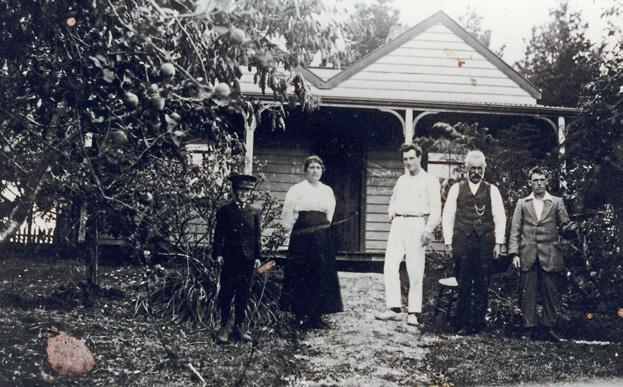
10 minute read
Three Solider Sons
By Ilma Hackett (Balnarring & District Historical Society).
(Information from “Three Names on an Honour Board” by Jack Cavanagh)
At the Anzac Day service held at Balnarring a prize is given to a pupil from each of the two schools in the district for their winning essay on what Anzac Day means to them. It is known as the John Cavanagh Award in honour of the young 22-year-old soldier from Balnarring who died in France in 1916 during World War One. John wasn’t the only son in the Cavanagh household who enlisted in the Great War. Two of the four younger sons also signed up to fight.
Enlistment and training
John Cavanagh was twenty and a half when he enlisted in the Australian Imperial Force (AIF) on 20 July 1915 soon after the attempted landing at Gallipoli. The eldest son of James and Euphemia Cavanagh, he had grown up on the family farm in Balnarring. After leaving Balnarring State School he worked as a farm hand until the war in Europe interrupted and he felt dutybound to join up. On enlistment he became Private Cavanagh No. 213 in the 29th Battalion’s A Company. He went to Broadmeadows to undergo the necessary medical check-up before he transferred to the nearby army camp where he received basic training. Although he had been placed with the Lewis gun Section, he learned how to handle many weapons such as hand grenades, rifles, bayonets and the machine guns with which his unit were issued. John learned how to dismantle, clean and reassemble the guns and how to quickly change an empty cartridge belt for a full one. Their unit also spent time on the rifle range where targets, set at different distances, were fired at using both rifles and machine guns.
The soldier reaches the Front Line
The order finally came to embark for overseas and on 10 November, 1915 John’s company left from Melbourne aboard ‘His Majesty’s Australian Transport (H.M.A.T.) Ascanius’. The ship reached Suez on 7 December where the soldiers disembarked for a further six months training in Egypt. Leave was given to all on several occasions and many headed into Cairo, some to see the pyramids, some seeking pleasure. In June of the following year the Company went to the Egyptian port of Alexandria to board the ship, ‘S.S. Tunisian’ for Marseilles in Southern France.
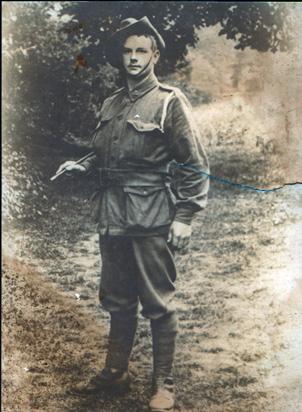
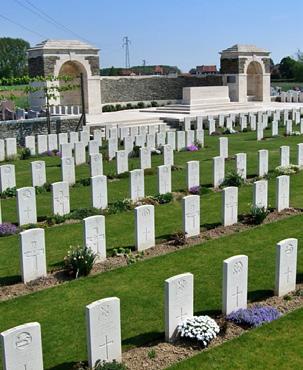
From the Marseilles railway station the men were put aboard a troop train that headed for northern France. Here they were billeted not far from the Front Line in the vicinity of Armentières. From their billets they could hear the distant gunfire from the war. Days passed, then came the order to march to the Front Line. About them lay ruins. As they moved forward, they met exhausted soldiers returning from long days of fighting in the trenches. The newcomers had to adapt quickly to life in the trenches: duckboards and sandbags, barbed wire and dug-outs, the noise, the stench and carnage.
Death and burial
John was in the trenches on 24 August ,1916 when a bullet struck him in the head. Stretcher bearers carried him to a casualty clearing station where he was declared dead from a wound to the face and skull. He had been at The Front just two months.
Six days later his body was buried in Éstaires Communal Cemetery in Northern France. Private John Cavanagh’s effects were returned to Balnarring and were collected by his mother – his identity disc, unit’s colours, electric torch, silver watch chain, metal watch, letters, French book and a linen bag.
Second son - Bill
Bill had enlisted on 18 June, 1915, shortly before John signed up.
He was the second of the five boys born to James Cavanagh and his wife, Euphemia. He had left school at fourteen and was working as a farm labourer. When the call reached Australia for young men to fight for Britain, he and John had discussed the issue with their parents. Neither boy was yet twenty-one years of age and parental consent was required to join the A.I.F. This took the form of a letter written by his father and also signed by his mother. It stated, “As my son William George wants to go to the front and serve his country. he has our consent.”
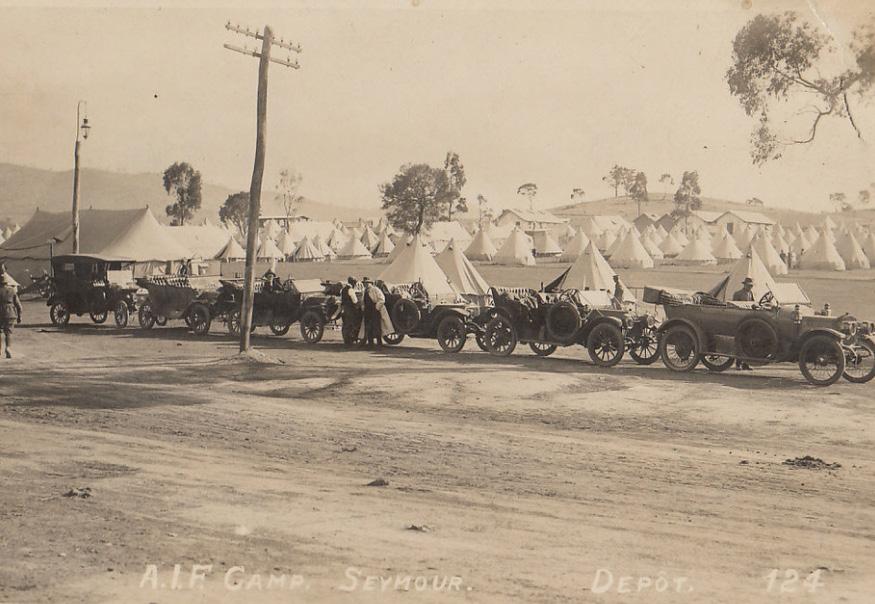
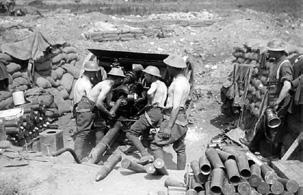
Bill was assigned to the 22nd Infantry Battalion and sent to Seymour to undertake basic training. Towards the end of August his unit sailed for England on ‘H.M.A.T. Anchesis’. Soon after arrival Bill was hospitalised firstly with measles which had been rife on the troop ship, then with jaundice. He was discharged from hospital on New Year’s Eve, 1915.
Once recovered he underwent further training at an English army base. This was designed to toughen the men physically for conditions at the battle front.
Gassed and a gunshot wound
Bill’s unit arrived in France and spent time at Calais, then Boulogne, Étaples and Amiens on the Somme River in Northern France. At times they travelled by troop train; at times they marched. A couple of weeks were spent at Breilly, near Amiens, before the order came for the men to march north-east to the Front Line to take their place in trench warfare.
He was in the trenches at Pozières in Northern France when, in 1916, he was exposed to a shelling attack by the German army. One onslaught of shells contained gas. Casualties were high.
Bill was also wounded in the thigh when struck by exploding pieces of shell. After initial treatment to remove some of the pieces, Bill was sent to Étaples for a further operation to remove more shell fragments. Thrombosis occurred, requiring further surgery. Once sufficiently recovered he was sent to a hospital in England and was finally repatriated to Australia in February, 1917. Although unfit for active duty, Bill felt he could still contribute and in May, 1918 he joined the Australian Medical Corps in Melbourne. He was discharged, at his request, in December, 1918 after the armistice was signed and fighting halted.
Jim, the boy soldier
Jim, the third son in the family had also left school when he turned fourteen to do farm work. The two youngest Cavanagh boys, Tom and Les, were still attending school in Balnarring. When his older brothers enlisted Jim was then fifteen and eager to join them and fight for King and Country. He pleaded with his parents to let him sign up too. They refused. Frustrated, Jim contemplated running off to enlist and putting up his age but persistence paid. After his sixteenth birthday his parents were finally persuaded to give their permission. He enlisted on 13 March, 1916, filling in his age as 22 years and 6 months on the enlistment forms. Taller than either of his brothers, Jim must have looked older than his actual years as he was accepted without question and placed with the 2nd Pioneers, A.I.F. Basic training was done at Broadmeadows before he left Melbourne for England on 6 June, 1916. By September the lad was in France.
Hospitalised
In April, 1917 Jim’s unit was in Bouzincourt in Northern France taking part in salvage work when he accidentally injured his left foot and face which put him in hospital. An enquiry into the incident was held and the result found the “soldier not to blame”. After eight days he returned to duty. His unit was sent to the trenches at the front line where one of the tasks required was to lay duckboards so that provisions could be brought up to the trenches. This also helped to speed up the evacuation of wounded soldiers. Mud was everywhere. and they were continually under bombardment. Jim was hospitalised in June suffering from trench fever, a disease spread by lice in the close confines of the trenches but he was able to rejoin his unit at the end of July.
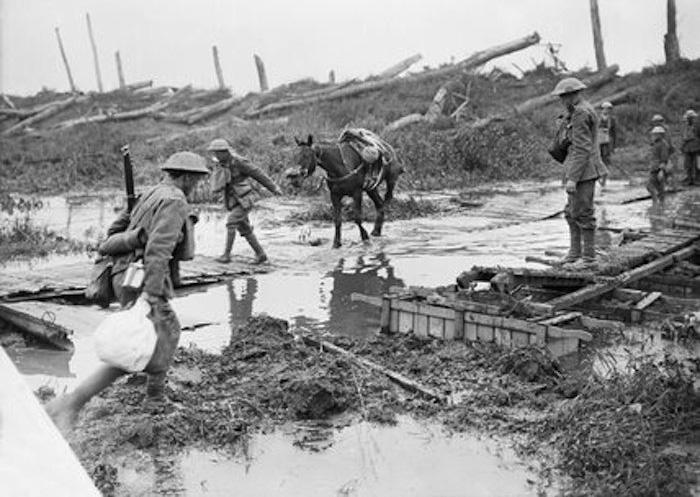
To live or not to live?
Shortly after his 17th birthday (5 September) Jim, officially reported to be at Ypres, was hit by shrapnel when an enemy shell exploded close by. One large piece of shrapnel almost completely severed his right leg and fractured the thigh bone. Stretcher bearers passed him by, considering he would not live through the night but when they found him still alive the next morning, he was taken to a field hospital and ultimately to the hospital in Boulogne where the doctors managed to save his leg. After almost four months at Boulogne Jim was sent to a hospital in England and, as soon as he was fit enough to travel, repatriated to Australia. The ship docked in Melbourne on 26 May, 1918 and Jim was transferred to the Caulfield Repatriation Hospital where he spent about six months before being discharged on 13 November as being medically unfit due to the wound to his leg.
Missing - AWOL
Whilst at the Caulfield hospital Jim went AWOL for several days. Later, his son Jack would write, “He was getting around quite well with the aid of a walking stick. One day he felt so well and, without caring, caught a train to Bittern and managed to get taken to Balnarring to be with his family and friends to enjoy home cooked meals and to sleep on a soft bed.” Jim was riled when he was docked three days’ pay and disappointed by what he thought was unfair treatment after all he had been though.
On discharge Jim was just one month past his 19th birthday, still younger than both his older brothers when they had enlisted.
The Wait
At ‘home’ in Balnarring Phyllis Cole recalled the “hushed horror and suspense” as news filtered through about the war casualties. “I can remember the church at Balnarring because there were families here – the Cavanaghs – and they had several sons in the army.”
Mother, Euphemia Cavanagh had her photograph in the ‘Argus’ newspaper acknowledging that she had two sons on active service at The Front and a third, at present in camp. The article was clipped from the newspaper and paper’s name and the date, ‘5 July 1916’, written beneath. Just over a month later, one of those sons had given his life on the battlefield.
A short time after receiving notification of the death of their son, John, on 24 August, James and Effie Cavanagh had a letter from France from son, Jim. His letter, dated 1 September told them that he had received a letter concerning John stating that there was every hope of him getting better. The Cavanaghs were thrown into confusion. James penned a letter to the Victoria Barracks stating, “It is only natural his Mother and me would like to no [sic] the truth”. He went on to add that mistakes occurred and asked if the authorities could find further news for them. James also stated that in one local paper it had been reported John died of wounds while in another it was reported he had ‘dangerous wounds’.
Any hope was shattered when the answer came.

References:
Unpublished manuscript: ‘Three Names on an Honour Board’ by Jack Cavanagh (son of Jim Cavanagh)
World War I Official Records
Photos: Cavanagh family collection held by B.D.H.S., Victorian Museum (Caulfield) Flickr (Seymour), Media Storehouse (Pozières)








